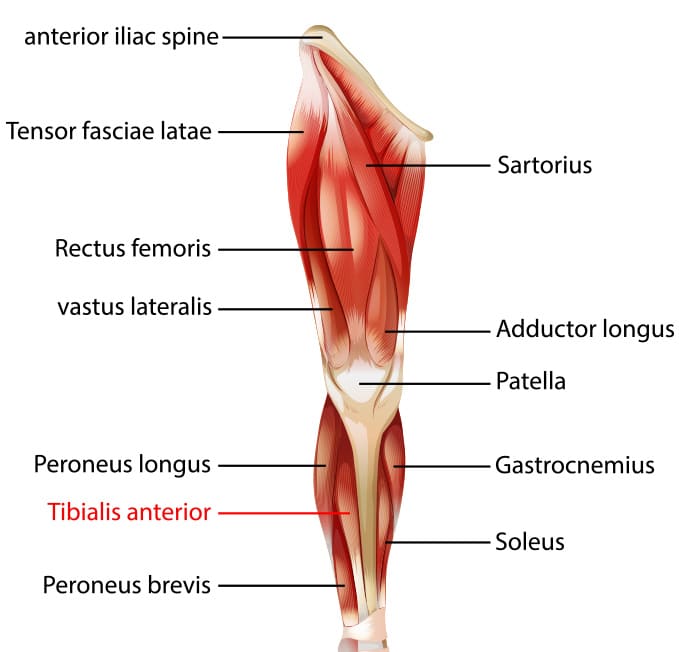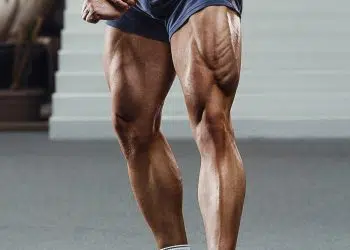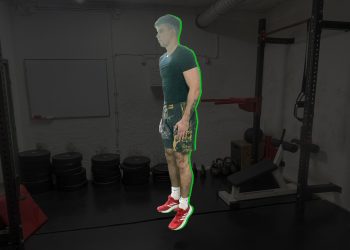There are over 600 muscles in the human body. Some, like the gluteus maximus, are large, strong, and obvious. Others are far smaller and often seem less important. However, every muscle plays a critical part in how your body functions.
As a bodybuilder or athlete, some muscles are more critical than others; they’re the ones you use to generate force or give your body its shape. Examples include the biceps, hamstrings, pectoralis major, and deltoids. It makes sense to spend plenty of training time and energy on these as they make up the bulk of your muscle mass.
However, there are several smaller muscles that also deserve your attention.
While they might not be as big, things like your rotator cuff, rhomboids, transverse abdominis, and hip flexors are also important. If any of these muscles are weak, your appearance may be affected. You could also be opening yourself up to an increased risk of injury.
In this article, we’re going to take a look at another small but critical muscle – the tibialis anterior. Located on the front of your shin, this muscle is basically the biceps of your lower leg.
Tibialis Anterior 101

Tibialis anterior is a long, narrow muscle located on the front of your shin. It originates at the top of your tibia or shin bone and inserts at the base of your foot. If you place your fingers on your outer shin and pull your toes up, you should feel your tibialis anterior contract.
Level Up Your Fitness: Join our 💪 strong community in Fitness Volt Newsletter. Get daily inspiration, expert-backed workouts, nutrition tips, the latest in strength sports, and the support you need to reach your goals. Subscribe for free!
The tibialis anterior is basically the opposite of your calves. Where gastrocnemius and soleus work together to plantar flex or extend your ankle, the tibialis anterior pulls your foot up toward your shin, a movement called dorsiflexion. In addition, the tibialis anterior plays a part in ankle inversion and helps support the arches of your feet.
You use your tibialis anterior whenever you walk or run. It pulls your toes up so they don’t catch on the floor as you transition from one step to the next.
A weak tibialis anterior can cause shin pain, often known as shin splits. This is a group of injuries usually caused by doing a lot of high-impact training, i.e., running and jumping.
In addition, the tibialis anterior can contribute to the size and shape of your lower legs. However, that contribution is quite small, and you’ll have to work your tibialis hard and often if you want it to get much bigger.
10 Best Tibialis Strengthening and Stretching Exercises
Whether you want to maximize lower leg size, avoid shin pain, or improve athletic performance, these are the best tibialis anterior strengthening and stretching exercises for you. Make sure you include both types of exercise in your lower leg training program.
1. Seated toe raise
Tibialis anterior exercises don’t come much more straightforward than the seated toe raise. You could probably do a set right now! If you have never trained your tibialis anterior before, you will probably find this exercise quite challenging, even though it doesn’t involve any additional weight.
Steps:
- Sit on a chair or bench with your knees bent and shins vertical.
- Keeping your heels on the ground, pull your toes up to your shins and lift the balls of your feet off the floor. Pause for 2-3 seconds.
- Lower your feet back down and repeat.
- Continue until you feel a deep burn in your shins.
Tips:
- Increase the range of motion by resting your heels on blocks or weight plates.
- Do sets of seated heel raises while working at your desk or relaxing at home to strengthen your tibialis anterior without having to add them to your workouts.
- Alternate between seated toe and heel raises to increase blood flow while sedentary, e.g., during a long-haul flight.
2. Standing tibialis anterior raises
While seated tibialis anterior raises are a great exercise, you may be glad to hear you can also train the fronts of your shins while standing. This is a weight-bearing exercise, so it’s arguably more functional than the seated variation.
Steps:
- Stand with your back to a smooth wall. Lean against it for balance. Your feet should be slightly out in front of you.
- Keeping your heels on the ground, pull your toes up to your shins and lift the balls of your feet off the floor.
- Lower your feet back down and repeat.
- Continue until you feel a deep burn in your shins.
Tips:
- Move your feet further forward to increase the range of motion and difficulty of this exercise.
- Pause at the top of each rep for 2-3 seconds to increase time under tension.
- Rest weight plate or dumbbells across your forefoot for more resistance.
3. Dumbbell toe raise
If you’ve mastered bodyweight toe raises, you are probably ready for a more demanding tibialis anterior workout. With this move, you use a dumbbell to overload your shin muscles, so you can increase the weight as you get stronger instead of just doing more and more reps.
Steps:
- Sit on an exercise bench and grip a dumbbell between your feet.
- Next, slide back on the bench so that your shins are supported.
- Moving your ankles only, lower the dumbbell down toward the floor and then pull it back up toward your shins.
- Continue for the desired number of repetitions.
Tips:
- You can also do this exercise with ankle weights wrapped around your feet, which may be more comfortable.
4. Resistance band seated toe raise
One of the most comfortable and convenient ways to overload your tibialis anterior muscles is with a resistance band. This is an ideal prehab/rehab exercise you can do at home. Like most resistance band exercises, this move is very joint-friendly.
Steps:
- Attach a resistance band to a sturdy anchor, e.g., a heavy dumbbell or squat rack.
- Sit on the floor with your legs extended. Loop the band over your foot and shuffle back to get the required tension.
- Extend your ankle and then pull your toes up against the resistance offered by the band.
- Continue for the required number of reps and then swap sides.
Tips:
- Wrap the band around your foot to prevent it from slipping.
- Wide, flat resistance bands are better for this exercise than round bands.
- The further back you move, the more demanding this exercise becomes. Therefore, you can shuffle forward as you start to get tired, doing a sort-of drop set.
5. Heel walks
While this exercise may look a little odd, it’s an effective and convenient way to build stronger, more enduring tibialis anterior muscles. Heel walks are popular with runners, who use them to ward off the dreaded shin splints. Bodybuilders can do heel walks between sets of calf raises to make their lower leg workouts more balanced and rounded.
Steps:
- In a clear space, pull your toes up, so your weight is on your heels.
- Keeping your legs straight, walk around your training area without letting the balls of your feet touch down.
- Continue until you cannot keep your toes up.
Tips:
- This exercise works best when performed barefoot or in minimalist shoes.
- Walk next to a wall or handrail if you find it hard to maintain your balance.
- Do not stick your butt out to compensate for pulling your toes up. Instead, maintain good posture throughout.
6. Tib bar toe raises
A tib bar is a device that allows you to train your tibialis anterior muscles with weight in relative comfort. Some gyms have tib bars, and they are also readily available for personal use. Unlike dumbbell toe raises, there is no real danger of dropping the weight. You can also increase the weight in small increments, making this the perfect exercise for progressive overload.
Steps:
- Load your tib bar with the required amount of weight. Put your feet into the device so one bar is across the top of your foot and the other is across the bottom.
- Sit on an exercise bench with your legs straight and your shins supported.
- Moving your ankles only, lower the weight down toward the floor and then pull it back up toward your shins.
- Continue for the desired number of repetitions.
Tips:
- You can also do this exercise using one leg at a time.
- Start with a light load and increase gradually to avoid overloading your muscles and triggering severe delayed onset muscle soreness.
7. Kneeling tibialis anterior stretch
While some people have weak tibialis muscles, muscle tightness is just as common. As such, stretching is as important as strengthening. This simple exercise also hits your ankle, knees, and quads. However, some people may find it uncomfortable.
Level Up Your Fitness: Join our 💪 strong community in Fitness Volt Newsletter. Get daily inspiration, expert-backed workouts, nutrition tips, the latest in strength sports, and the support you need to reach your goals. Subscribe for free!
Steps:
- Kneel on the floor with your ankles pointed, and the tops of your feet pressed into the floor.
- Gently lower your butt to your heels and sit back, so your weight pushes your ankles deeper into the floor.
- Sit in this position for 60 seconds or more, easing into a deeper stretch as your muscles relax.
Tips:
- Kneel on a folded mat or cushion for comfort.
- Place a yoga block between your feet if you cannot lower your butt all the way down. Sit on the yoga block instead of your heels.
- This exercise is not suitable for people with preexisting knee pain.
8. Toe drag
The toe drag is a great way to incorporate tibialis anterior stretches into your workouts without sitting or kneeling down. You can do it in your regular workout shoes, but it works even better when you do it barefoot.
Steps:
- Stand in good posture.
- Shift your weight onto one leg and push the toes of your other foot into the floor.
- Press your ankle forward to get a stretch in the front of your shin.
- Hold for 10-30 seconds, and then swap sides.
Tips:
- Use a wall balance and support if required.
- You can also do this exercise seated – like this:
9. Side lying tibialis anterior stretch
Do you want to stretch your quads and tibialis anterior at the same time? Then this is the exercise for you! It’s more knee-friendly than the kneeling tibialis anterior stretch (#7) and considerably more comfortable, too. Just take care not to pull on your feet too aggressively, as that could lead to injury.
Steps:
- Lie on your side and rest your head on one arm.
- Bend your uppermost leg, reach back, and grip the top of your foot below your toes.
- Pull your foot into your butt, stretching both your glutes and ankle.
- Hold for 30-90 seconds, increasing the depth of the stretch as you feel you feel your muscles start to relax.
- Roll over and repeat on the opposite side.
Tips:
- If you cannot comfortably reach your foot, wrap a towel around your toes and pull on that instead. This will allow you to stretch your ankle without over-stressing your knees, hips, back, or shoulders.
- You can also do this exercise while lying flat on your front.
10. Upward-facing dog
The upward-facing dog is a yoga pose that stretches the front of your entire body, including the tibialis anterior. This exercise is the perfect antidote to long periods of sitting and a great way to relax and stretch close to half your major muscles.
Steps:
- Lie on your front with your legs together, toes pointed, and hands beneath your shoulders. Pull your shoulders back and down and brace your abs.
- Extend your arms and lift your chest and shoulders off the floor.
- Lift your hips and press your ankles downward.
- Hold this position for 30-60 seconds.
- Lower your body back to the floor, rest briefly, and repeat.
Tips:
- Do this exercise on a mat for comfort.
- Breathe slowly and evenly throughout, preferably through your nose.
- Extend your arms as far as possible, but without overstressing your lower back.
Tibialis Anterior FAQs
Do you have a question about tibialis anterior exercises or training? Don’t worry – we’ve got the answers?
1. How many reps should I do for my tibialis anterior?
The tibialis anterior is a relatively small, weak muscle. As such, it’s usually impractical to train it with heavy loads or low reps. That’s especially true if you are new to tibialis anterior exercises. So, for best results, train your tibialis anterior with light to moderate loads and medium to high reps, e.g., 10-20.
However, when doing bodyweight tibialis anterior exercises, you should simply rep out to failure, doing as many reps as possible. Depending on the exercise, this could be as high as 30 reps per set.
2. How many times per week should I train my tibialis anterior?
2-3 tibialis anterior workouts per week should be sufficient for most people. This will provide the ideal balance between work and rest. More than this is probably unnecessary, and fewer workouts (i.e., one per week) will not be as effective.
Remember to include strengthening AND stretching exercises in your tibialis anterior workouts.
3. When should I train my tibialis anterior?
You can train your tibialis anterior muscles whenever it is convenient. One option is when you train your calves, or you can work them at home whenever you have a few minutes spare. This is a good solution for many people as most tibialis anterior exercises require no special training equipment.
4. Do I really need to train my tibialis anterior muscles?
The answer to this is – it depends!
Suppose you are an athlete, especially a runner, who wants to avoid the shin pain often caused by weak tibialis anterior muscles. In that case, it’s probably a good idea to train them to prevent future problems.
However, if you are a bodybuilder with no interest in preventing shin pain or improving your athletic performance, you probably won’t benefit much from adding tibialis anterior exercises to your workouts.
5. I have shin splints – what should I do?
Firstly, it’s important to understand that shin splints are a general term for any pain in the anterior lower leg. As such, it can be caused by several things.
For example, some shin splits are caused by tibialis anterior muscle or tendon inflammation. In contrast, others can be the result of stress fractures in the tibia or shin bone.
As such, it’s best to have your shin pain diagnosed properly so you know if it’s the result of soft tissue problems or hairline stress fractures. However, in both cases, rest will help the healing process, and strengthening and stretching exercises can reduce the risk of developing shin pain in the first place.
Closing Thoughts
The tibialis anterior is one of those muscles that not everyone needs to train. It’s important for athletes, especially runners, but much less critical for bodybuilders and weightlifters.
So, should you train your tibialis anterior? Maybe!
If you have a history of shin pain or just want to avoid it in the future, tibialis anterior strengthening and stretching may help. However, if you just want to be muscular and strong, you probably won’t get much benefit from training this muscle.











